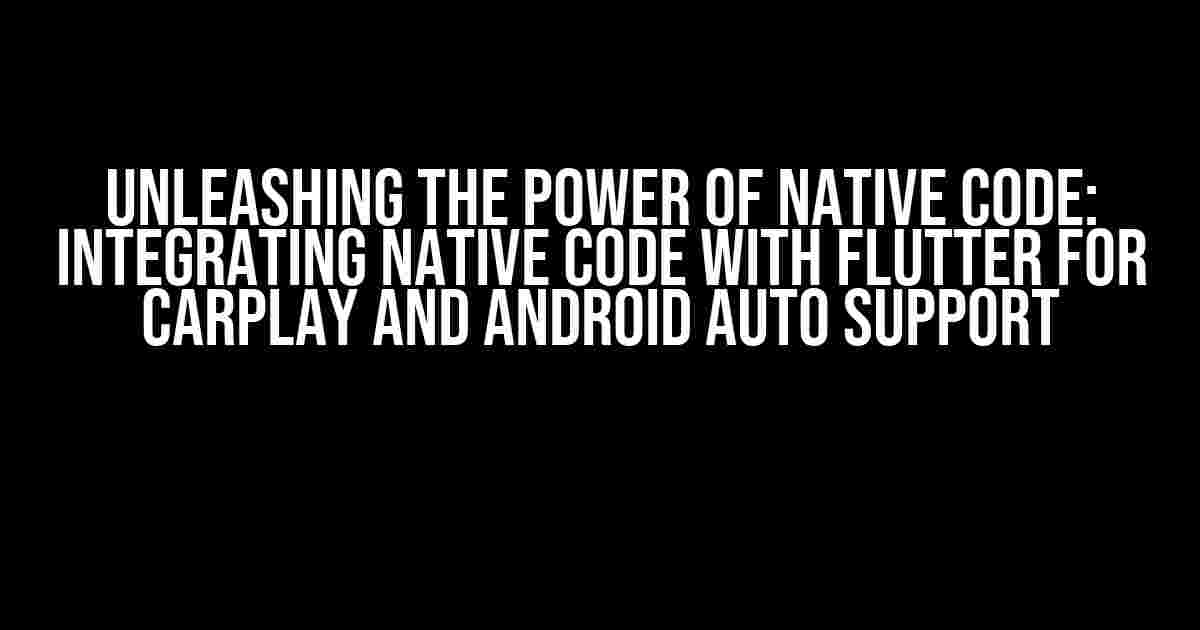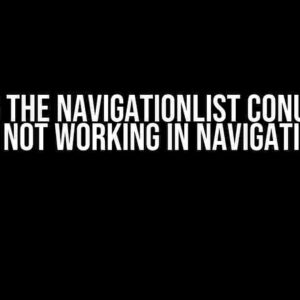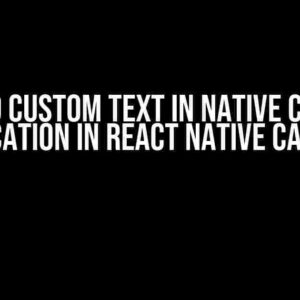As the world becomes increasingly mobile, the demand for seamless in-car experiences has never been higher. Flutter, the popular cross-platform development framework, has made significant strides in this domain by allowing developers to create captivating user interfaces for CarPlay and Android Auto. However, to unleash the full potential of these platforms, it’s essential to integrate native code with Flutter. In this comprehensive guide, we’ll delve into the world of native code integration, exploring the benefits, challenges, and step-by-step instructions for incorporating native code with Flutter for CarPlay and Android Auto support.
Why Integrate Native Code with Flutter?
Flutter’s “write once, run anywhere” philosophy has revolutionized the development landscape. However, when it comes to CarPlay and Android Auto, native code integration becomes crucial for several reasons:
- Platform-specific features**: CarPlay and Android Auto offer unique features that can only be accessed through native code, such as maps, navigation, and media controls.
- Performance optimization**: Native code can optimize performance-critical components, ensuring a smoother user experience.
- Security and authentication**: Integrating native code enables you to leverage platform-specific security features, such as biometric authentication and encryption.
Preparing Your Flutter Project for Native Code Integration
Before diving into native code integration, ensure your Flutter project is set up correctly:
flutter doctor: Verify that your Flutter installation is up-to-date and functioning correctly.flutter create: Create a new Flutter project, or open an existing one, using the command-line interface.pub get: Fetch dependencies for your project using the Pub package manager.
Install the necessary plugins for CarPlay and Android Auto support:
dependencies:
flutter:
sdk: flutter
flutter_carplay: ^2.0.0
flutter_android_auto: ^1.0.0
Integrating Native Code with Flutter for CarPlay Support
For CarPlay support, you’ll need to integrate native code using the following steps:
Step 1: Create a CarPlay entitlement
In your Xcode project, navigate to the “Capabilities” tab and add the “CarPlay” entitlement:
com.example.yourapp.CarPlayEntitlement |
Bundle Identifier |
Step 2: Implement the CarPlay interface delegate
Create a new Swift file, CarPlayInterfaceDelegate.swift, and implement the CPInterfaceDelegate protocol:
import CarPlay
class CarPlayInterfaceDelegate: NSObject, CPInterfaceDelegate {
func interface(_ interface: CPInterface, didConnect CarPlayInterfaceConnection connection: CPInterfaceConnection) {
// Handle CarPlay connection
}
func interface(_ interface: CPInterface, didDisconnect connection: CPInterfaceConnection) {
// Handle CarPlay disconnection
}
}
Step 3: Integrate the CarPlay interface delegate with Flutter
In your Flutter project, create a new Dart file, car_play_interface.dart, and use the platform_channels plugin to communicate with the native CarPlay interface delegate:
import 'package:flutter/services.dart';
class CarPlayInterface {
static const platform = const MethodChannel('com.example.yourapp/carplay');
Future connectToCarPlay() async {
await platform.invokeMethod('connectToCarPlay');
}
Future disconnectFromCarPlay() async {
await platform.invokeMethod('disconnectFromCarPlay');
}
}
Integrating Native Code with Flutter for Android Auto Support
For Android Auto support, you’ll need to integrate native code using the following steps:
Step 1: Add the Android Auto dependency
In your Android project’s build.gradle file, add the Android Auto dependency:
dependencies {
implementation 'com.google.android. Auto: AutoSdk:2.0.0'
}
Step 2: Create an Android Auto service
Create a new Java file, AndroidAutoService.java, and extend the CarDataService class:
import com.google.android.Auto.AutoService;
import com.google.android.Auto.CarDataService;
public class AndroidAutoService extends CarDataService {
@Override
public void onCreateSession(Bundle savedInstanceState) {
// Handle Android Auto session creation
}
@Override
public void onDestroySession() {
// Handle Android Auto session destruction
}
}
Step 3: Integrate the Android Auto service with Flutter
In your Flutter project, create a new Dart file, android_auto_service.dart, and use the android_intent plugin to communicate with the native Android Auto service:
import 'package:flutter/services.dart';
import 'package:android_intent/android_intent.dart';
class AndroidAutoService {
static const platform = const MethodChannel('com.example.yourapp/androidauto');
Future startAndroidAutoService() async {
await platform.invokeMethod('startAndroidAutoService');
}
Future stopAndroidAutoService() async {
await platform.invokeMethod('stopAndroidAutoService');
}
}
Best Practices for Native Code Integration
To ensure a seamless native code integration experience:
- Keep native code minimal**: Only use native code for platform-specific features and performance-critical components.
- Use a modular architecture**: Organize your code into separate modules for easier maintenance and updates.
- Test thoroughly**: Perform extensive testing to ensure compatibility and functionality across different platforms and devices.
Conclusion
In this comprehensive guide, we’ve explored the benefits and challenges of integrating native code with Flutter for CarPlay and Android Auto support. By following the step-by-step instructions and best practices outlined above, you’ll be well on your way to creating captivating in-car experiences that take advantage of platform-specific features and native code optimization. Remember to stay up-to-date with the latest developments in Flutter and native code integration to ensure your app remains ahead of the curve.
Happy coding!
Frequently Asked Question
Get answers to some of the most commonly asked questions about integrating native code with Flutter for CarPlay and Android Auto support.
What is the primary benefit of integrating native code with Flutter for CarPlay and Android Auto support?
The primary benefit is that it allows you to leverage the strengths of both Flutter and native platforms, enabling you to create a seamless and native-like experience for users in CarPlay and Android Auto environments. This integration enables you to reuse Flutter widgets and business logic while still accessing native platform features and functionalities.
What are the key challenges of integrating native code with Flutter for CarPlay and Android Auto support?
Some of the key challenges include managing the complexity of native platform integrations, dealing with differences in platform-specific APIs and behaviors, and ensuring that your Flutter app meets the unique requirements and guidelines of CarPlay and Android Auto. Additionally, you’ll need to handle communication between the native and Flutter layers, which can be a complex task.
How do I integrate native code with Flutter for CarPlay support on iOS?
To integrate native code with Flutter for CarPlay support on iOS, you’ll need to create a custom CarPlay framework that communicates with your Flutter app using the Flutter platform channels. You’ll also need to implement the CarPlay API, which involves creating a CarPlay-enabled app that can handle user input and provide a navigation-based interface.
What are the requirements for integrating native code with Flutter for Android Auto support?
To integrate native code with Flutter for Android Auto support, your app must meet the Android Auto app requirements, which include providing a media-based or messaging-based interface, handling voice commands and intents, and ensuring that your app is compatible with the Android Auto environment. You’ll also need to use the Android Auto SDK and implement the necessary native platform code to communicate with the Android Auto system.
Are there any tools or libraries available to simplify the integration of native code with Flutter for CarPlay and Android Auto support?
Yes, there are several tools and libraries available that can simplify the integration process. For example, the Flutter CarPlay plugin provides a set of pre-built widgets and APIs for building CarPlay-enabled apps. Similarly, libraries like Flutter Android Auto and Flutter CarPlay Android Auto provide a set of pre-built components and APIs for building Android Auto and CarPlay-enabled apps. These libraries can save you time and effort by providing a more streamlined integration process.





